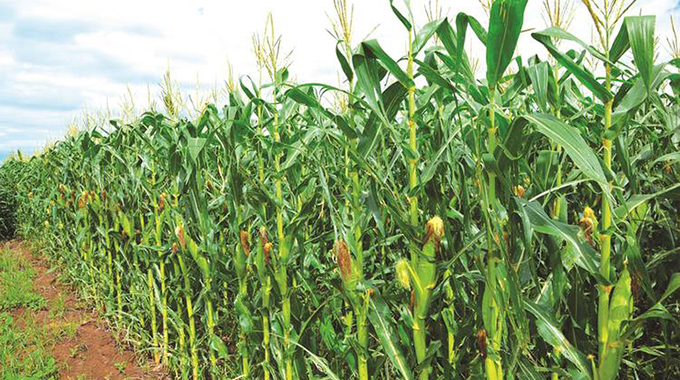
THE partnership between the Government and sugar manufacturing giant, Tongaat Hulett to produce 1 186 tonnes of irrigated winter maize under the Smart Agriculture concept is commendable and provides important lessons for the country.
Maize produced under the initiative is meant to enhance food security in the drought-prone Masvingo Province, which is naturally a victim of perennial food shortages caused by recurrent droughts and low rainfall patterns associated with the region.
It is common knowledge that the 1 186 tonnes of maize will supplement the little the province will produce in the 2019-20 cropping season and this should go a long way in easing shortages.
It is therefore critical for the programme to be done all year-round considering that the region has high temperatures most of the time that will support maize production.
There are vast water bodies in the province that have been lying idle for years since their establishment decades ago.
The grossly under-utilised Siya Dam in Zaka and Bindamombe Dam in Chivi easily come to the mind.
There is Runde River and Tugwi-Mukosi where there is abundant water that can be harnessed for the winter maize project.
The project currently running in Masvingo was introduced by former governor of the province, Josaya Hungwe after the 1992 drought.
Zambia, under the leadership of President Rupiya Banda came and took notes from the project and has managed to create a green belt at Siavonga just across Kariba Dam and has since experienced 10 times growth in agricultural production to the point of exporting grain to Zimbabwe.
As a country, we are doing the project on a piecemeal basis yet we have all the conditions needed for us to do it full time.
In the Lowveld, there are ARDA estates that can be utilised for such programmes.
Chisumbanje is a good candidate for the project, while the Zambezi escarpment stretching from Jambezi to Kanyemba, down to Rushinga in Mt Darwin has hot temperatures all year-round that can be taken advantage of to grow maize or any other crops throughout the year to boost food security.
ARDA Mushumbi and ARDA Muzarabani, for instance, have some of the most ideal climatic conditions for the programme and such places should provide the springboard for the launch of all year-round maize production projects.
Command Agriculture should in fact have started from those projects and spread to other parts of the country.
There is no justification whatsoever for us not to be utilising these natural conditions to boost food security and even start exports from there.
The programme can be done on a national scale if resources are availed.
It can easily be replicated countrywide in all the arid regions, which happen to be characterised by hot weather that can be tapped into for the production of staple crops like maize or any other cereal that can be identified for the project.
It will take the commitment of Government, concerned stakeholders, development partners and cooperating local authorities for such a programme to take off.
Lands, Agriculture, Water and Rural Resettlement Minister Air Chief Marshal (Rtd) Perrance Shiri recently hinted at an agriculture recovery plan launch that the Government would prioritise turning the country’s dry areas into green belts as a way of enhancing food security.
That is a noble idea by all standards.
Perennial food deficits in regions such as Matabeleland, the Zambezi basin, parts of Manicaland and Masvingo may easily be accounted for and this will cut the country’s huge import bill on food.
The programme surely deserves to be extended to cover other crops that are not necessarily maize.
Crops like wheat and soya beans are also worth giving a try.
It is also crucial for agricultural research institutions to come to the party and do serious investigations on more crops that can be included in projects like this so that focus is not trained on just one crop.
Crop diversity will also allow the country to produce surplus for value addition and exports and not just for the belly as is the current situation in which everybody is seized with producing to address food security issues.
If the entire country was to adopt the programme it would also be crucial to explore other energy systems such as solar for powering irrigation infrastructure because the current power cuts do not auger well for the success of such programmes. Irrigation requires energy to pump water from the dams into the canals.
We salute the move by Tongaat Hulett to contribute to the national cause of food security and urge the authorities and partners to spread the initiative to other parts of the country and also expand it to cover other crops like wheat, soya beans and sugar beans.
